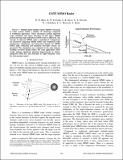| dc.contributor.author | Bliss, Daniel W., Jr. | |
| dc.contributor.author | Forsythe, Keith W. | |
| dc.contributor.author | Davis, Shakti K. | |
| dc.contributor.author | Fawcett, Glenn S. | |
| dc.contributor.author | Rabideau, Daniel J. | |
| dc.contributor.author | Horowitz, Larry L. | |
| dc.contributor.author | Kraut, Shawn | |
| dc.date.accessioned | 2010-10-06T18:26:57Z | |
| dc.date.available | 2010-10-06T18:26:57Z | |
| dc.date.issued | 2009-03 | |
| dc.date.submitted | 2009-02 | |
| dc.identifier.isbn | 978-1-4244-2970-7 | |
| dc.identifier.other | INSPEC Accession Number: 10545533 | |
| dc.identifier.uri | http://hdl.handle.net/1721.1/58911 | |
| dc.description.abstract | Multiple-input multiple-output (MIMO) extensions to radar systems enable a number of advantages compared to traditional approaches. These advantages include improved angle estimation and target detection. In this paper, MIMO ground moving target indication (GMTI) radar is addressed. The concept of coherent MIMO radar is introduced. Comparisons are presented comparing MIMO GMTI and traditional radar performance. Simulations and theoretical bounds for MIMO GMTI angle estimation and minimum detectable velocity are presented. The simulations are evaluated in the time domain, enabling waveform design studies. For some applications, these results indicate significant potential improvements in clutter-mitigation SINR loss and reduction in angle-estimation error for slow-moving targets. | en_US |
| dc.description.sponsorship | United States. Dept. of the Air Force (contract FA8721-05-C-0002) | en_US |
| dc.language.iso | en_US | |
| dc.publisher | Institute of Electrical and Electronics Engineers | en_US |
| dc.relation.isversionof | http://dx.doi.org/10.1109/WDDC.2009.4800327 | en_US |
| dc.rights | Article is made available in accordance with the publisher's policy and may be subject to US copyright law. Please refer to the publisher's site for terms of use. | en_US |
| dc.source | IEEE | en_US |
| dc.title | GMTI MIMO radar | en_US |
| dc.type | Article | en_US |
| dc.identifier.citation | Bliss, D.W. et al. “GMTI MIMO radar.” Waveform Diversity and Design Conference, 2009 International. 2009. 118-122. ©2009 Institute of Electrical and Electronics Engineers. | en_US |
| dc.contributor.department | Lincoln Laboratory | en_US |
| dc.contributor.approver | Bliss, Daniel W., Jr. | |
| dc.contributor.mitauthor | Bliss, Daniel W., Jr. | |
| dc.contributor.mitauthor | Forsythe, Keith W. | |
| dc.contributor.mitauthor | Davis, Shakti K. | |
| dc.contributor.mitauthor | Fawcett, Glenn S. | |
| dc.contributor.mitauthor | Rabideau, Daniel J. | |
| dc.contributor.mitauthor | Horowitz, Larry L. | |
| dc.contributor.mitauthor | Kraut, Shawn | |
| dc.relation.journal | 2009 International Waveform Diversity and Design Conference | en_US |
| dc.eprint.version | Final published version | en_US |
| dc.type.uri | http://purl.org/eprint/type/JournalArticle | en_US |
| eprint.status | http://purl.org/eprint/status/PeerReviewed | en_US |
| dspace.orderedauthors | Bliss, D. W.; Forsythe, K. W.; Davis, S. K.; Fawcett, G. S.; Rabideau, D. J.; Horowitz, L. L.; Kraut, S. | en |
| mit.license | PUBLISHER_POLICY | en_US |
| mit.metadata.status | Complete | |

